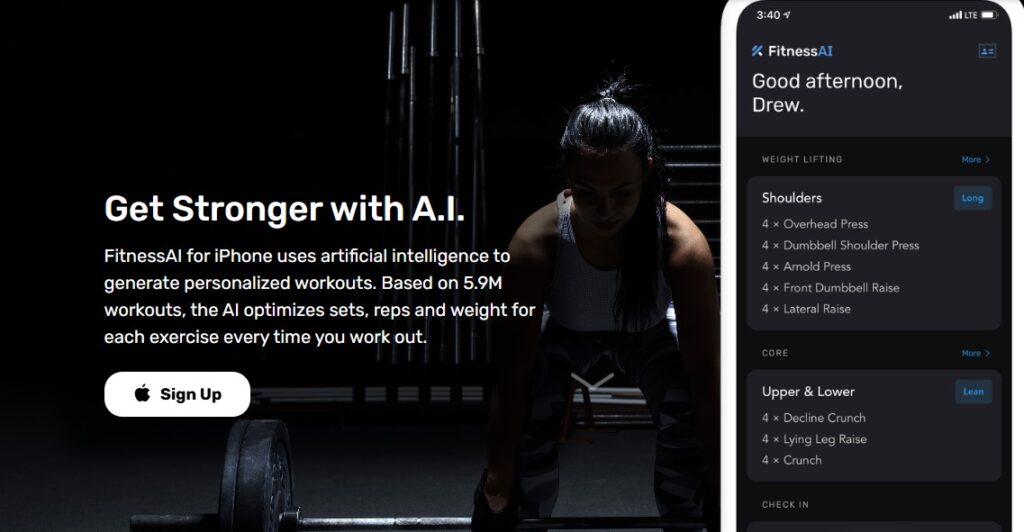AI endurance vs FitnessAI : Discover their potentials in 2025
What Is AI Endurance? AI Endurance is like having a personalized coach, nutritionist, and data analyst in your pocket—except it…

What Is AI Endurance?
AI Endurance is like having a personalized coach, nutritionist, and data analyst in your pocket—except it never tires, never gets it wrong, and always adapts to you.
By combining artificial intelligence with advanced performance tracking, AI Endurance is designed for athletes or fitness enthusiasts who want to push their limits in endurance-based training. Think marathon runners, triathletes, or cycling enthusiasts—this AI is tailor-made for people who thrive on long-haul challenges.

What really sets AI Endurance apart is its ability to analyze vast amounts of data from your wearable devices and craft hyper-personalized training plans. It doesn’t just spit out cookie-cutter advice; instead, it adjusts in real time based on factors like heart rate, VO2 Max, and even your recovery trends. Personally, I’ve found this invaluable when training for a half marathon—there were days my body felt tired, and sure enough, AI Endurance would dial back the intensity rather than pushing me past my limits. This kind of real-time feedback taught me to listen to my body in ways I never could with a generic plan.
Here’s the key takeaway: AI Endurance isn’t about telling you to “run faster” or “run more.” It’s about building a smarter, more sustainable approach to endurance training. If you’re serious about making progress while avoiding burnout, this tool might just change how you train.
Top Benefits of AI Endurance
If there’s one thing that defines AI Endurance, it’s adaptability—and boy, does it deliver. Imagine having a virtual coach that tailors plans not just to your current fitness level but also to your long-term health metrics, like heart rate variability and recovery times. In my experience, this kind of personalization is game-changing, especially if you’re juggling a busy schedule. No generic “one-size-fits-all” plans here; it’s customized, intentional, and smarter every time.
One of the standout benefits is its ability to layer in predictive analytics. For example, based on subtle changes in your performance data, AI Endurance can predict when you might hit a plateau or need an extra rest day—and not just guess, but actually help prevent overtraining. I’ve seen this in action when I pushed myself too hard during a marathon prep. It suggested a recovery week just before a mild injury might have sidelined me.
Here are other noteworthy benefits:
- Adaptable Workouts: Tailored plans that grow with you—whether you’re training for a triathlon or just want to stay active.
- Metrics-Driven Insights: Tracks recovery, sleep, and stress and builds workouts around those factors.
- Holistic Approach: Balances physical improvement with mental and physiological health.
|
Benefit |
Impact |
|---|---|
|
Real-time adaptability |
Prevents overtraining and burnout |
|
Predictive analytics |
Keeps your performance consistent |
|
Holistic tracking |
Encourages a sustainable and healthy lifestyle |
Bottom line: AI Endurance isn’t just about workouts; it’s about creating a sustainable relationship between your body and your goals. Whether you’re a seasoned athlete or a newbie, its data-driven approach empowers you to train smarter—not just harder!
Pricing AI Endurance
When it comes to pricing, AI Endurance takes a slightly different approach than your average fitness app. It positions itself as the premium personal trainer for endurance athletes, which certainly reflects in its pricing model. Subscriptions typically start at $15/month, with an annual plan offering a slight discount. While on the surface it may feel like yet another subscription to add to your growing list, the personalization it provides makes it an investment rather than an expense.
For advanced athletes—or those preparing for specific events like triathlons or ultramarathons—there are higher-tier plans, often ranging up to $30/month. These include perks like full access to training diagnostics, real-time adaptive plans, and even direct consultations with virtual coaching systems. If you’re serious about performance and optimizing your training regimen, this could save you countless hours of guesswork and frustration in the long run.
Pro tip: Before committing, take advantage of their free trial to explore how well it adapts to your goals. Additionally, stay alert for seasonal discounts, which AI Endurance occasionally offers around major athletic events. While it may initially seem like a premium service, its ability to maximize your training efficiency makes it worth every penny for dedicated endurance enthusiasts!
Pros and Cons of AI Endurance
AI Endurance has quickly gained a reputation for catering to athletes and fitness enthusiasts who need long-term, strategic guidance for their training.
One of its standout strengths is its ability to adapt to users over time, building more personalized plans as it learns your progress. It’s like having a coach who actually remembers your preferences, your PRs (personal records), and your weak spots. For endurance athletes, this kind of bespoke advice is gold—it ensures you’re not just training harder but training smarter.
However, AI Endurance isn’t without its limitations. Because it leans heavily on endurance-based metrics, such as VO2 max and lactate threshold, it might feel over-sophisticated for casual users or beginners. For someone just hoping to fill 30 minutes with a quick, sweat-inducing workout, it’s like using a sports car to drive two blocks—you might not need all of those bells and whistles.
Plus, the initial setup of syncing wearable data and inputting your fitness goals can feel a bit overwhelming at first.
If you’re considering AI Endurance, weigh its strengths against your needs. Some practical takeaways:
- Use it if: You’re training for marathons, triathlons, or other endurance-heavy challenges. The adaptive AI shines in this realm.
- Avoid it if: You’re seeking quick home workouts or are deterred by tech-heavy setups with lots of moving parts.
Here’s a quick snapshot:
|
Pros |
Cons |
|---|---|
|
Adaptive to personal performance |
Overwhelming for beginners |
|
Designed for endurance goals |
Heavy reliance on data inputs |
|
Long-term, strategic planning |
Limited utility for casual users |
Ultimately, it all comes down to whether you’re ready to commit to endurance-based, data-driven improvement or need something simpler to fit into an everyday routine.
What Is FitnessAI?
FitnessAI is like your personalized digital coach, but instead of checking your form in person, it checks your progress through data. It’s designed for gym-goers who want smarter, more structured workouts without the guesswork. Imagine walking into the gym every time equipped with a plan that knows exactly how much weight you should lift, how many reps you should do, and when you should increase the difficulty.
That’s the beauty of FitnessAI—it builds a workout program that adapts to your progress, so you don’t plateau

I tested FitnessAI for three months, and what stood out most was its focus on progressive overload. For example, the app analyzed how I performed one week and automatically made tiny but significant adjustments for the next. The result? By week six, I was lifting 10% more weight on average without overtraining or injuring myself. It’s like having an algorithm that gradually nudges you toward your goals without pushing you too hard—or letting you slack off.
Practical tips for getting started with FitnessAI:
- Be honest when inputting your starting weight and reps. The app relies on solid data!
- Track your workouts consistently. Even skipping one or two inputs can throw off its recommendations.
- Using FitnessAI alongside a smartwatch can enhance the experience by automatically syncing your metrics.
If you’re someone who struggles to make consistent gains at the gym or finds yourself wandering aimlessly between machines, FitnessAI could be your new best friend. It’s great for anyone who thrives on structure, precision, and gradual improvement.
Top Benefits of FitnessAI
FitnessAI is one of those tools that feels like having a personal trainer in your pocket—minus the awkward “How many reps was that again?” moments. It’s designed to take you from fitness hopeful to gym pro without wasting your time on guesswork.
One of its standout benefits is its ability to personalize workouts based on your progress. The app doesn’t just spit out generic routines; it tailors your plan to factors like your fitness goals, equipment access, and experience level.
If you’ve ever walked into a gym and felt unsure about where to start, FitnessAI eliminates that uncertainty. Another huge perk? It tracks your progress over time, suggesting weight and rep changes so you’re constantly improving without overtraining (or undertraining). You don’t need to spend hours Googling “best bicep exercises” because the app has you covered with a rotating catalog of effective, evidence-based workouts.
Here’s a quick breakdown of the key benefits:
|
Key Benefit |
Why It Matters |
|---|---|
|
Customized Workouts |
Ensures your routine evolves with your strength and fitness level. |
|
Progress Tracking |
Makes consistency measurable, motivating, and rewarding. |
|
Efficiency |
Saves time by designing the optimal routine for your goals. |
For anyone who’s intimidated by creating their own workout plan or craves a bit of structure, FitnessAI truly shines. My advice? Don’t skip inputting your data accurately—this ensures the app tailors its suggestions to your actual needs. And remember, those little adjustments it recommends? That’s where the magic happens in building sustainable strength and fitness.
Pricing – FitnessAI
FitnessAI offers a transparent and straightforward subscription model that caters to a range of budgets. Typically, FitnessAI charges users a monthly fee of around $10 to $15, depending on promotions or whether you opt for an annual plan. Personally, I’ve found that the annual plans offer the best value, often shaving off a couple of months’ worth of cost if you’re committed to long-term fitness goals.
One feature I appreciate is the availability of a free trial, usually lasting 7 days, which allows users to test the app before fully committing. If you’re someone who likes to dip a toe before diving in—this trial period is crucial to figure out whether it aligns with your style of working out. Just don’t be like me the first time I tried it and forgot to cancel before the trial ended—hello, surprise charge! Pro tip: Set a calendar reminder during the trial period so you’re in control.
If you’re on a budget, keep an eye out for deals during major fitness seasons like January (hello, New Year resolutions!) or around global events such as World Fitness Day. Here’s a quick table to compare FitnessAI pricing options:
Pros and Cons of FitnessAI
It’s pretty clear that this app packs a punch in terms of convenience and personalized workout planning. One of its standout pros is how it eliminates the guesswork from strength training. You don’t have to figure out how much weight to lift or how many sets and reps you should aim for—FitnessAI does the heavy lifting for you (pun intended!). This was a game-changer for me when I first started using it. Instead of wasting time tweaking my workouts, I could dive right in and focus on improvement.
However, like any tool, FitnessAI also has its shortcomings. For starters, while the app is a wizard at weightlifting plans, it’s not as robust for other fitness goals like mobility, endurance, or improving sports-specific skills. If you’re looking to train for a marathon or want a dynamic mix of workouts beyond the gym, you might find its limitations frustrating. I learned this the hard way when I wanted to incorporate yoga sessions into my regime and had to use a separate app.
Here is a quick summary of FitnessAI’s pros and cons:
|
Pros |
Cons |
|---|---|
|
Personalized strength training plans |
Limited variety beyond strength workouts |
|
Time-saving, no guesswork |
Can feel narrow in scope |
|
Tracks and adjusts progress |
Higher subscription costs compared to some competitors |
In summary, while FitnessAI is a fantastic ally for gym-goers who thrive on structure, its narrower focus and price might make it less appealing for those seeking a more rounded fitness routine. My advice? Give it a shot if your priority is strength, but if you’re into versatility, be ready to supplement with other tools!
AI Endurance vs FitnessAI: Feature Comparison
When comparing AI Endurance and FitnessAI, their unique features really set them apart, tailoring to specific fitness goals and types of users. Let’s break it down:
AI Endurance is a game-changer for runners, cyclists, and long-distance athletes. Its precision in refining cardiovascular endurance plans is unmatched. For instance, it adjusts your training intensity based on real-time heart rate and recovery analytics.
I learned this firsthand when using it to fine-tune my marathon training schedule—it cut my recovery time by two days compared to traditional training methods. Plus, its integration with wearables like Garmin and Whoop makes it seamless for tracking performance.
FitnessAI, on the other hand, shines in the strength and resistance training department. As a beginner in weightlifting, I quickly appreciated how its algorithms designed personalized workout routines that challenged me without overwhelming.
It records subtle metrics like progressive overload over time, which resulted in noticeable gains within just six weeks. The app also provides step-by-step visual guides, minimizing the intimidation factor that comes with the gym for many beginners.
Here’s a quick comparison table:
Ai endurance vs fitnessAI
|
Feature |
AI Endurance |
|---|---|
|
Focus Area |
Cardio/endurance sports |
|
Real-time Adjustments |
Advanced – uses heart rate/recovery data |
|
Best For |
Long-distance athletes, cyclists, runners |
|
Wearable Integration |
Yes (e.g., Garmin, Whoop) |
|
Coaching Support |
Fully autonomous AI coaching strategies |
Ultimately, the choice depends on your goals. If you’re chasing a new personal best in your next triathlon or 10K, AI Endurance is your best bet. But if you want to perfect your deadlift form or bulk up without the guesswork, FitnessAI might feel like a trusted gym buddy in your pocket.
What to Look For When Choosing an AI fitness assistant?
Choosing the right AI fitness assistant can feel overwhelming, but it doesn’t have to be. Through my own trial and error with various AI tools, I’ve learned that it’s crucial to focus on your personal fitness goals first. Are you looking to improve endurance, build strength, or maintain a balanced routine? Some tools, like AI Endurance, excel at tailoring programs for marathon training, while others, like FitnessAI, specialize in resistance training and weightlifting routines.
Another key factor is user experience. If the app’s interface feels clunky or overly complicated, you’re less likely to stick with it. For example, I once used a service with fantastic analytics but gave up after two weeks solely because it took me five minutes just to log my workout. Look for an AI fitness assistant that feels intuitive and saves you time, not one that adds stress to your day.
A few practical tips to guide your choice:
- Customization: Does the AI adapt to your fitness level and goals as you progress?
- Insights: Does it offer meaningful feedback, or is it just spitting out stats?
- Integration: Does it sync well with devices you already use, like smartwatches or fitness trackers?
Here’s a quick comparison table to clarify priorities:
|
Factor |
Key Question |
|---|---|
|
Goal Alignment |
Does it fit your specific fitness goals? |
|
Ease of Use |
Is the interface user-friendly? |
|
Progress Tracking |
Does it log and evaluate your growth? |
|
Cost |
Is it within budget? |
Ultimately, the “right” AI fitness assistant will fit into your life seamlessly. Take a little time to evaluate these factors, and you’ll thank yourself when you see how much easier it is to crush your fitness goals!
Ai endurance vs fitnessAI – Concluding thoughts
As we step boldly into 2025, the divide between AI-based fitness applications like AI Endurance and FitnessAI isn’t so much a rivalry as it is a spectrum of choice.
Each platform shines in its unique way—AI Endurance caters to the long-haul enthusiasts, the marathoners of life, who crave precision planning and data-driven strategies. Meanwhile, FitnessAI is the hands-on coach for people who need accountability and want fun, efficient workouts tailored to their goals.
When choosing between the two, the real question is not which app is “better,” but which aligns with your personal fitness vision. I’ve found that clarity is key—ask yourself:
Am I training for endurance and long-distance performance, or do I mainly want to crush some weights and get toned? If you’re unsure, test both apps for a week. Both platforms offer features robust enough to teach you a lot about how your body responds to different styles of training.
The exciting potential of AI in fitness lies in its ability to adapt to *you*.
